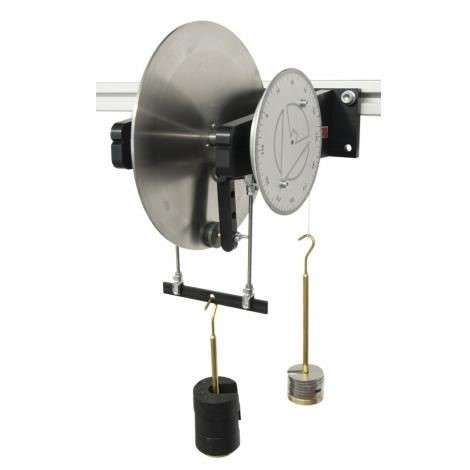EM-125 | Disk & Drum Brake Apparatus
- Wall mounted apparatus.
- One stainless steel disc; four brake pad materials.
- Three pad radii.
- 360° Protractor for angle recording.
- Full set of weights and hangers.
- Compact bench top apparatus.
- Simulation of Real braking system.
- Industry available brake shoes.
- Leading and Trailing configuration easily arranged.
- Full set of weights and hangers supplied.
- Length: 450 mm,
- Width: 200 mm,
- Height: 260 mm,
- Weight: 30 kg.
Description
Technical Specification
Media
A brake disc is mounted vertically into a sturdy frame. A single shaft runs through the brake disc and the wall bracket supports. A cord pulley mounts to the shaft onto which is mounted a cord terminating in a Load hanger.
Two bell crank levers are mounted either side of the brake disc. Through the Load hanger and calibrated weights, the force is applied to the brake disc and the parameters of braking force, braking torque, normal force can be assessed. All Load hangers, and calibrated weights are supplied with the apparatus. The rotational angle of movement of the disc wheel can be viewed using the external protractor.
Different brake pad materials can be tested as well as their radial position on the brake disc.
An aluminum brake drum is secured to one end of a sturdy bench top mounted base. The drum has an external cord grooved and its inside face is machined to plain aluminum. A cord is wrapped around the perimeter of the brake drum and the free end of the cord runs over a pulley at the other end of the base and terminates with a Load hanger. Torque is applied to the brake drum by using the calibrated weights set provided and the Load hanger.
Mounted inside the brake drum is a single brake shoe with its own pivot. A second cord connects to the brake shoe and again runs over a pulley and terminates at the Load hanger. As the load is applied to the brake shoe so that friction force increases. The student must then add load to the torque hanger to try and rotate the brake drum at near constant speed. The sense of rotation of the torque determines whether the single brake shoe acts as a leading or trailing shoe. Direct comparison of tangential force and braking load is obtained and the coefficient of friction determined.
Drum Brake Apparatus
Learning Objectives
- To determine experimentally the variation of tangential force with braking load
- To obtain the coefficient of friction between the aluminum drum and the brake shoe
- To compare leading and trailing shoes
- Stainless steel disc wheel: Ø210mm x 3mm
- Radial positions for brake pad: 20mm intervals
- Brake pad: Ø25mm x 6mm max
- Brake pad: Brake material, aluminium, brass, nylon
- Protractor: 360°, 1° increments
- Weights set: 3 x 0.1N, 8 x 0.2N, 3 x 1N, 3 x 2N, 1 x 5N
- 2 x Load hanger
Any questions? We are happy to help...
+49 40 670 854 - 0
sales@gunt.de
Newsletter
About Us
EduTech Lahore excels in designing and supplying cutting-edge equipment for Engineering Education in Mechanical,Polymer
Chemical, Civil and Control Engineering. Focused on meeting the demand for quality education, we offer cost-effective solutions for the latest teaching equipment.
Contact Info
Head Office (Asia)
EduTech
Lahore
- EduTech Lahore, 2nd Floor, Plaza No.1009, Block-F, Commercial Area, State Life Insurance Employees Cooperative Housing Society Limited, Lahore.
- info@edutechlahore.com
- +92 321 88 35034
- (042) 35460635
Regional Partner Office (UK)
- Jactin House 24 Hood Street Ancoats M4 6WX
- info@edutechlahore.com
- +44 0161 676 7299
Sales Partner (Middle East) GCC International FZC
- G3.Al Awail building, Indusrial Area Al jurf 2. Ajman United Arab Emirates
- sales.uae@ syptechnologies.com
- +971 0161 676 7299


